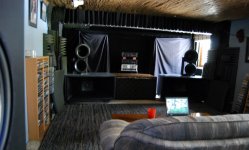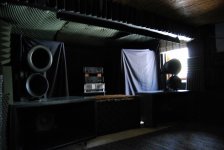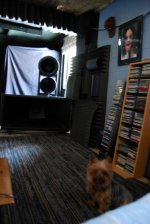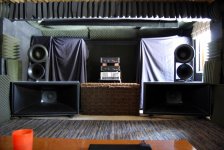I'm doing the final tuning on the Stargate 6 System
The satellite horns from 100 cycles up are centered on the JBL CMCD cone midrange compression drivers, That are quite spectacular in what they do in a horn system where we always have a longing to extend the midrange horn to cover the lower midrange through the vocal range but come up short using conventional compression drivers and cones. Most large format compression drivers even in the biggest most awkward horns barely make to 500 cycles and are weak below there leaving the listener with bleached out, distorted, unnatural sound lacking in tonal density and natural fundementals. The cone loaded mid drivers have the opposite problem with the cone breakup, lack of phase plugs, mass roll off, and general lack of upper range presence, power response and dynamics. The JBL CMCD81H is the answer, It addresses all the problems with the traditional compression drivers and all the problems with horn loaded cone midrange drivers all in one sleek package. Load it in a good horn and mate it with the appropriate bass, upper midrange and treble horns and you will have world class playback. Beyond the whatever...
Beyond the whatever...
http://www.jblpro.com/ProductAttachments/CMCD_TechNote.pdf
CMCD Cone Midrange Compression Driver
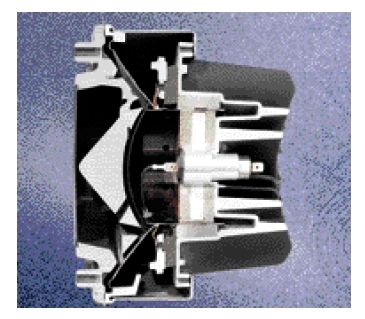
The satellite horns from 100 cycles up are centered on the JBL CMCD cone midrange compression drivers, That are quite spectacular in what they do in a horn system where we always have a longing to extend the midrange horn to cover the lower midrange through the vocal range but come up short using conventional compression drivers and cones. Most large format compression drivers even in the biggest most awkward horns barely make to 500 cycles and are weak below there leaving the listener with bleached out, distorted, unnatural sound lacking in tonal density and natural fundementals. The cone loaded mid drivers have the opposite problem with the cone breakup, lack of phase plugs, mass roll off, and general lack of upper range presence, power response and dynamics. The JBL CMCD81H is the answer, It addresses all the problems with the traditional compression drivers and all the problems with horn loaded cone midrange drivers all in one sleek package. Load it in a good horn and mate it with the appropriate bass, upper midrange and treble horns and you will have world class playback.
http://www.jblpro.com/ProductAttachments/CMCD_TechNote.pdf
CMCD Cone Midrange Compression Driver
An externally hosted image should be here but it was not working when we last tested it.

Last edited:
I found a like new pair on ebay. They are listed on the JBL dealer price sheet as separate parts, the 2169H midrange driver 339111-001X and then the phase plug 338471-003 . The bug screen is also a separate part number - There are online dealers that sell the 2169H for around $500.00 but I never tried to buy the phase plug since I found a complete pair. So yes the driver is available but you may need to go through a JBL parts dealer (or JBL direct) to get the phase plug.
JBL 339111-001X / 2169H SRX738 8" MID FREQUENCY DRIVER REPLACEMENT
If you know a JBL parts dealer they may be able to assist you.
http://www.jblproservice.com/pdf/Misc.%20Parts%20List/Misc%20Parts%20List%20(by%20part).pdf
JBL 339111-001X / 2169H SRX738 8" MID FREQUENCY DRIVER REPLACEMENT
If you know a JBL parts dealer they may be able to assist you.
http://www.jblproservice.com/pdf/Misc.%20Parts%20List/Misc%20Parts%20List%20(by%20part).pdf
An externally hosted image should be here but it was not working when we last tested it.
Don't get what they are trying to add with the text here. Interesting driver for sure
Last edited:
The text is all explained in the white paper in the OP:Don't get what they are trying to add with the text here. Interesting driver for sure
http://www.jblpro.com/ProductAttachments/CMCD_TechNote.pdf
Simply put, they integrated a nice little heat transferring enclosure (compression chamber) and a phase plug for 6.5" or 8" cone loudspeakers that has a 4" exit which can be bolted on to 4" entrance horns.
Saves some DIY work, if the horn you plan to use happens to have a 4" throat.
For the presence region above the CMCD horns I use the best compression driver I have found for that range. It is aluminum 3" dome/2" exit with bi-laminate polyamide aluminum surround. It is from the people that designed the original Emilar drivers but better sound. The Radian people build something similar with less quality and lesser craftsmanship. If you like what you hear from Emilar or the Radian people I suggest you get the Renkus Heinz SSD 3301. They are better built and perfected the clamping system for the diaphragm to get better sound and lower distortion. These are short exit drivers with very low IM distortion. In the range of 1200 to 6K they have the smoothest sound I have found in compression drivers. Being small format and only 3" diaphragm I choose not to run them below 1800 where 3" drivers begin to sound anemic and strained. So I cross at 2K to 6K where they sing like no other.
ftp://ftp.renkus-heinz.com/Legacy_Products/Datasheets_and_Drawings/Classic_RH_Drivers/SSD3301_data.pdf
ftp://ftp.renkus-heinz.com/Legacy_Products/Datasheets_and_Drawings/Classic_RH_Drivers/SSD3301_data.pdf
Last edited:
POOH,
Can you get replacement diaphragms for the RH SSD 3301?
I don't trust used compression drivers not to have been abused, thus want the option to repair.
Correct me if I am wrong, but the SSD 3001 is no longer in production.
Doug
No, I've never blown a compression driver in 20 years. In this case I keep a couple of spares since the drivers typically sell for under 100 dollars
For the treble in a horn system the best solution is small exit high performance compression driver in a suitable horn that will give and allow the power and delicacy of the high frequencies of the music to be reproduced coherently with the rest of the horn array in a way where that it is never noticed and the highs never sound strained or artificial. With other solutions and many other compression driver solutions what I most often get is a spitty sound (like the B&C 250, Beyma 380, BMS garbage, ECT) that takes away the joy of the music and puts you in the "audiophile", "listener" mode. Those drivers should be avoided at all cost. Or we have drivers that are too smooth in the treble and never give you the realistic bite of real instruments. Drivers in that category include air motion transformers, ribbon and planar tweeters, most ring radiators and domes. These "smooth" drivers always also stick out in the music in an annoying way where they are dynamically compressed compared to a good compression driver in a matched treble system horn. I have heard ribbons, AMT domes sound good but never perfect or real. If you use low or mid efficiency methods (under 103 db w/m) then they will be unsuitable fpr horns systems but fine for that purpose but avoid them at all cost if you value realistic uncompromised sound with horn arrays.
Last edited:
For the treble in a horn system the best solution is small exit high performance compression driver
Smaller than 1 inch? Any examples?
I have come to the same conclusions as you with respect to the subjective differences between comp drivers, dome tweeters, ribbons etc. No holy grail as yet but I have had some luck with a piezo driver in a Motorola horn stuffed with reticulated foam!
Piezos (motorola) can sound pretty good, I use a couple with some Fullrange 12" Eminence for my patio speakers and they are surprisingly excellent and at times sound realistic
I use 1" compression drivers for treble in the horn system. The tiny Celestion 1425 is the best treble driver I have found for this system. It's only good down to 2.5K even in a 350 flare horn though so it's more of a treble driver than a 2-way driver. As a treble driver it has a vivid natural big sound with no compression or "spit. I use it with the little Faital tractrix horn above 6K . The combination fills the room with high frequency energy and has great inner detail - cymbal splashes with the right recording sound exactly correct as well as bells, chimes, harmonics ECT
Compression Drivers / Neo - CDX1-1425 - Celestion - Guitar, Bass & Pro Audio Speakers
FaitalPRO | HF Horns | STH100
I use 1" compression drivers for treble in the horn system. The tiny Celestion 1425 is the best treble driver I have found for this system. It's only good down to 2.5K even in a 350 flare horn though so it's more of a treble driver than a 2-way driver. As a treble driver it has a vivid natural big sound with no compression or "spit. I use it with the little Faital tractrix horn above 6K . The combination fills the room with high frequency energy and has great inner detail - cymbal splashes with the right recording sound exactly correct as well as bells, chimes, harmonics ECT
Compression Drivers / Neo - CDX1-1425 - Celestion - Guitar, Bass & Pro Audio Speakers
FaitalPRO | HF Horns | STH100
So what are you liking these days at the different price points?
I think we have similar tastes in speakers, bought a few things you liked years back and really enjoyed them.
hello, I'm posting the horn system here right now. For the critical range 80 to 300 Hertz I am using a straight expo horn with 250 pounds of sand in it's enclosure. The driver is the Electro Voice EVM15L - the EV15L is a great driver in these horns and in this range it's probably the most efficient 15" driver on the planet. This is one of those things you have to hear to understand what it can do. Getting that range right takes a straight horn and lots of tweaking in my experiance - once you're there or close it can sound so real it will literally scare you.
http://www.electrovoice.com/downloadfile.php?i=971123
Last edited:
admiration of your mid-bass !
I Love the mid-bass horn ! If you wouldn't mind answering, what are the dimensions ?
hello, I'm posting the horn system here right now. For the critical range 80 to 300 Hertz I am using a straight expo horn with 250 pounds of sand in it's enclosure. The driver is the Electro Voice EVM15L - the EV15L is a great driver in these horns and in this range it's probably the most efficient 15" driver on the planet. This is one of those things you have to hear to understand what it can do. Getting that range right takes a straight horn and lots of tweaking in my experiance - once you're there or close it can sound so real it will literally scare you.
http://www.electrovoice.com/downloadfile.php?i=971123
I Love the mid-bass horn ! If you wouldn't mind answering, what are the dimensions ?
Last edited:
Hi POOH,
A really impressive looking rig
Could you please elaborate on drivers and crossover points - thanks!
Best regards
Peter
A really impressive looking rig
Could you please elaborate on drivers and crossover points - thanks!
Best regards
Peter
Hello,
The midbass horn enclosure is 24" by 24" by 47" wide. They are filled with sand and are loaded with Celestion BX4085 15" bass drivers. The BX15-4085 is chosen for its pure sound and low distortion. In the horn it's not quite as efficient as the EVM15L but still around 107 db with a watt.
I use the midbass horn 120 to 300 cycles (plus minus 1 db at 4 feet) then handoff to the JBL CMCD81H 300 to 2K then the top is the Celestion CDX1-1425
The midbass horn enclosure is 24" by 24" by 47" wide. They are filled with sand and are loaded with Celestion BX4085 15" bass drivers. The BX15-4085 is chosen for its pure sound and low distortion. In the horn it's not quite as efficient as the EVM15L but still around 107 db with a watt.
An externally hosted image should be here but it was not working when we last tested it.
I use the midbass horn 120 to 300 cycles (plus minus 1 db at 4 feet) then handoff to the JBL CMCD81H 300 to 2K then the top is the Celestion CDX1-1425
An externally hosted image should be here but it was not working when we last tested it.
An externally hosted image should be here but it was not working when we last tested it.
Thanks for your reply - it looks really great
Best regards
Peter
Best regards
Peter
Hello,
The midbass horn enclosure is 24" by 24" by 47" wide. They are filled with sand and are loaded with Celestion BX4085 15" bass drivers. The BX15-4085 is chosen for its pure sound and low distortion. In the horn it's not quite as efficient as the EVM15L but still around 107 db with a watt.
An externally hosted image should be here but it was not working when we last tested it.
I use the midbass horn 120 to 300 cycles (plus minus 1 db at 4 feet) then handoff to the JBL CMCD81H 300 to 2K then the top is the Celestion CDX1-1425
An externally hosted image should be here but it was not working when we last tested it.
An externally hosted image should be here but it was not working when we last tested it.
- Status
- This old topic is closed. If you want to reopen this topic, contact a moderator using the "Report Post" button.
- Home
- Loudspeakers
- Multi-Way
- Stargate 6 Horn System
